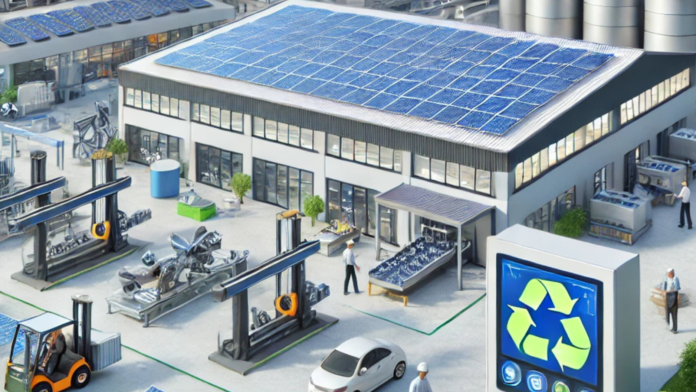In the rapidly evolving industrial landscape, renewable energy adoption has become a cornerstone for sustainable manufacturing. Manufacturing sectors, being energy-intensive, are increasingly under pressure to reduce their carbon footprints. By integrating renewable energy sources into their operations, manufacturers not only meet regulatory requirements but also reap economic benefits while enhancing their corporate social responsibility. Here’s a look at best practices for integrating renewable energy into manufacturing operations.
1. Energy Audits and Efficiency Optimization
Before transitioning to renewable energy, manufacturers should conduct comprehensive energy audits. An energy audit identifies areas of energy inefficiency, offering solutions to optimize energy consumption. This often involves upgrading equipment, retrofitting old systems, or implementing smart energy management systems to reduce overall energy usage. Optimizing energy use allows manufacturers to decrease energy demand, making the shift to renewables more cost-effective.
2. On-Site Renewable Energy Generation
A growing number of manufacturers are investing in on-site renewable energy generation, such as solar panels or wind turbines. By producing energy on-site, companies gain control over their energy sources and can reduce their dependence on external electricity grids. For instance, companies like Tesla and BMW have installed large solar arrays at their manufacturing facilities, which not only provide power to their operations but also allow them to feed excess energy back into the grid, creating an additional revenue stream.
Key Technologies for On-Site Generation:
– Solar Photovoltaic (PV) Systems: Ideal for factories with large roof space. Solar panels are a popular choice because of decreasing costs and increasing efficiency.
– Wind Turbines: Suitable for facilities located in windy regions. Turbines can generate substantial amounts of energy for large manufacturing operations.
– Bioenergy: In industries with access to biomass, bioenergy systems can convert waste into usable energy.
3. Power Purchase Agreements (PPAs)
For manufacturers that may not have the capacity or infrastructure to generate renewable energy on-site, Power Purchase Agreements (PPAs) are an effective alternative. A PPA is a long-term contract between a manufacturer and a renewable energy provider, allowing the company to purchase renewable energy at a fixed rate without the need for upfront capital investment. This strategy helps manufacturers reduce carbon emissions and energy costs without incurring the costs of installing and maintaining renewable energy infrastructure.
4. Energy Storage Solutions
One of the challenges of renewable energy, particularly solar and wind, is its intermittent nature. To address this, energy storage solutions, such as batteries, are essential. By storing excess energy generated during peak renewable production periods, manufacturers can ensure a consistent energy supply during times of low production or high demand.
– Battery Storage: Lithium-ion batteries are widely used, but advancements in technology are paving the way for more efficient and cost-effective solutions, such as solid-state batteries.
– Thermal Energy Storage: Excess renewable energy can be stored as heat, which is particularly useful for industries that require large amounts of thermal energy, such as cement or steel manufacturing.
5. Green Certifications and Reporting
Adopting renewable energy not only improves sustainability but also opens up opportunities for certifications and awards. Programs like LEED (Leadership in Energy and Environmental Design) and ISO 50001 (Energy Management Systems) recognize companies for their energy efficiency and use of renewable resources. These certifications enhance a company’s reputation, demonstrating a commitment to environmental stewardship and making them more attractive to eco-conscious consumers and business partners.
Furthermore, transparent reporting on renewable energy use, carbon footprint reduction, and energy savings is crucial. Many companies now publish annual sustainability reports that highlight their achievements and goals in reducing energy consumption and increasing renewable energy adoption.
6. Collaboration with Energy Providers
Manufacturers can collaborate with energy providers to develop custom renewable energy solutions. This includes joint investments in large-scale renewable projects or partnerships with utilities to integrate renewable energy into their operations. These collaborations help manufacturers access a broader range of renewable energy sources and scale their usage in a cost-effective manner.
7. Leveraging Government Incentives
Governments across the globe are offering various incentives, grants, and tax breaks for companies that adopt renewable energy. Manufacturers should research available incentives and leverage them to offset the costs of renewable energy investments. In many countries, there are subsidies for installing solar panels, investing in energy-efficient machinery, or conducting energy audits. These incentives help manufacturers achieve faster returns on investment.
8. Continuous Monitoring and Improvement
Adopting renewable energy is not a one-time project but a long-term commitment. Manufacturers should continuously monitor energy consumption, renewable energy production, and storage efficiency. Advanced software solutions and IoT-based monitoring systems enable real-time tracking of energy performance and facilitate data-driven decision-making. With ongoing improvements, manufacturers can refine their energy strategies and ensure they are maximizing the benefits of renewable energy.
Conclusion
The integration of renewable energy into manufacturing is more than just an environmental responsibility; it is a sound business strategy that reduces operational costs, enhances energy security, and boosts corporate reputation. By adopting best practices such as energy audits, on-site generation, PPAs, and energy storage, manufacturers can position themselves as leaders in the green energy revolution. As technology continues to evolve, the transition to renewable energy will become increasingly accessible, transforming the future of manufacturing.
—
This article offers valuable insights for manufacturers looking to adopt renewable energy strategies. Would you like any specific details or case studies included to enrich the content further?















